
Concept explainers
A substance that ____ is considered to be a chemical compound.
- a. contains at least two different elements
- b. contains at least two atoms
- c. has a
chemical bond - d. has a stable valence shell
- e. has covalent bonds
Introduction:
Substances are made up of chemical components that are composed of either the same elements or different elements. It may be in different forms such as solid, liquid, and gaseous state.
Answer to Problem 1TYR
Correct answer:
A substance that contains at least two different elements is considered to be a chemical compound. Therefore, option a is correct.
Explanation of Solution
Justify reasons for the correct statement:
Substances that are composed of two or more different elements are said to be chemical compounds. Option (a) is given as “contains at least two different elements”. Hence, option (a) is correct.
Justify reasons for the incorrect statements:
Option (b) is given as “contains at least two atoms”, it is said to be diatomic in nature. Hence, it is a wrong answer.
Option (c) is given as “has a chemical bond” all atoms are joined by a chemical bond. Hence, it is a wrong answer.
Option (d) is given as “has a stable valence shell”. It is the outermost orbital of an atom. Hence, it is a wrong answer.
Option (e) is given as “has covalent bond”. It is defined as the chemical bond that shares two electrons of two different atoms. Hence, it is a wrong answer.
Hence, options (b), (c), (d), and (e) are incorrect.
Substances are made up of at least two different elements in a chemical component. Elements are linked by chemical bonds with different atoms. Substances may be in three different phases.
Want to see more full solutions like this?
Chapter 2 Solutions
Anatomy & Physiology: The Unity of Form and Function
Additional Science Textbook Solutions
Marine Biology (Botany, Zoology, Ecology and Evolution)
Genetics: Analysis and Principles
Biology: Concepts and Investigations
- Oxygen (O) is a(n) _______; the oxygen we breathe (O2) is a(n) _______; and the carbon dioxide we exhale is a(n) _______. a. compound; molecule; element b. atom; compound; element c. element; atom; molecule d. atom; element; molecule e. element; molecule; compoundarrow_forwardAlchemists were the forerunners of modern-day chemists. Many of these medieval scholars and philosophers spent their lives trying to transform lead (atomic number 82) into gold (atomic number 79). Explain why they never succeeded.arrow_forwardMagnesium has an atomic number of 12. Which of the following statements is true of a neutral magnesium atom? a. It has 12 protons, 12 electrons, and 12 neutrons. b. It has 12 protons, 12 electrons, and six neutrons. c. It has six protons, six electrons, and no neutrons. d. It has six protons, six electrons, and six neutrons.arrow_forward
- Which of the following statements is not true? a. Water is polar. b. Water stabilizes temperature. c. Water is essential for life. d. Water is the most abundant atom in Earth’s atmosphere.arrow_forwardAtoms share electrons unequally in an _______ bond. a. ionic c. polar covalent b. hydrogen d. nonpolar covalentarrow_forwardWhich type of bond represents a weak chemical bond? a. hydrogen bond b. ionic bond c. covalent bond d. polar covalent bondarrow_forward
- Which of the following statements is incorrect? a. Isotopes have the same atomic number and different mass numbers. b. Atoms have about the same number of electrons as protons. c. All molecules consist of atoms. d. Free radicals are dangerous because they emit energyarrow_forwardThe nucleus of an atom contains: a. neutrons and electrons b. protons and electrons c. protons only d. neutrons and protons e. neutrons onlyarrow_forward. A cation is a(n)a. uncharged atom.b. positively charged atom.c. negatively charged atom.d. atom that has gained an electronarrow_forward
- The partial negative charge at one end of a water molecule is attracted to the partial positive charge of another water molecule. What is this attraction called? (a) a hydrogen bond (b) a van der Waals interaction (c) an ionic bond (d) a covalent bond (e) a hydrophilic bondarrow_forwardThe atomic number gives thea. number of neutrons in the nucleus.b. number of protons in the nucleus.c. weight of the atom.d. number of protons in the valence shell.arrow_forward
 Concepts of BiologyBiologyISBN:9781938168116Author:Samantha Fowler, Rebecca Roush, James WisePublisher:OpenStax College
Concepts of BiologyBiologyISBN:9781938168116Author:Samantha Fowler, Rebecca Roush, James WisePublisher:OpenStax College Biology: The Dynamic Science (MindTap Course List)BiologyISBN:9781305389892Author:Peter J. Russell, Paul E. Hertz, Beverly McMillanPublisher:Cengage Learning
Biology: The Dynamic Science (MindTap Course List)BiologyISBN:9781305389892Author:Peter J. Russell, Paul E. Hertz, Beverly McMillanPublisher:Cengage Learning Biology (MindTap Course List)BiologyISBN:9781337392938Author:Eldra Solomon, Charles Martin, Diana W. Martin, Linda R. BergPublisher:Cengage Learning
Biology (MindTap Course List)BiologyISBN:9781337392938Author:Eldra Solomon, Charles Martin, Diana W. Martin, Linda R. BergPublisher:Cengage Learning
 Biology Today and Tomorrow without Physiology (Mi...BiologyISBN:9781305117396Author:Cecie Starr, Christine Evers, Lisa StarrPublisher:Cengage Learning
Biology Today and Tomorrow without Physiology (Mi...BiologyISBN:9781305117396Author:Cecie Starr, Christine Evers, Lisa StarrPublisher:Cengage Learning





